Voice of the Customer (VoC) is how companies hear and listen to customer feedback about their brand, products, and services. VoC solutions help you gather that feedback and turn it into valuable data and insights at scale. Data-driven VoC analytics programs are proven to increase customer lifecycle value and lower customer churn. There are six steps involved in building an effective VoC analytics program:
- Identify a question
- Gather and prepare data
- Choose your tools
- Analyze and troubleshoot
- Draw conclusions
- Take action
In order, this article will:
- Outline the business value of good customer experiences
- Demonstrate how to process customer feedback and reviews using text analytics and natural language processing
- Explain how to use these insights to improve experiences and revenue
- Show the value of building a multi-channel Voice of Customer analytics program
- Suggest further reading and resources
What is Voice of the Customer?
Voice of Customer is defined as “the customer’s voice, expectations, preferences, comments, of a product or service in discussion. It is the statement made by the customer on a particular product or service” (courtesy SixSigma).
Therefore, a Voice of Customer data analytics program is a structured system of feedback collection, data analysis, and action planning.

The main goal of VoC analytics is to understand how people perceive and interact with brands, products, and services.
The Value of Voice of Customer & Customer Experience Management
In the age of social media, one viral review can burn down an entire brand. The onus is on businesses to deliver excellent experiences. As it stands, 89% of companies will compete mainly on customer experience, according to Gartner research.
But this state of affairs isn’t a bad thing. The opportunity is huge. Research by Bain & Co. has found:
- Companies that excel at customer experience grow revenues 4-8% above their competition
- Superior experiences deliver 6-14x higher customer lifecycle value
- Voice of customer programs result in up to 55% greater client retention
Indeed, improving your customer experiences creates colossal value. But to make informed, effective changes, you must listen to your customers. And to truly listen to your customers, you must understand the conversations they’re having about your products, brands, and services.
How to Capture the Voice of Customer
Every VoC process starts by collecting customer feedback. The most straightforward data source is surveys. Tools like SurveyMonkey, Typeform, and Zoho Survey make it a snap to create and distribute your customer experience surveys. However, surveys are inherently limited. After all, you only get answers to the questions you ask.
Another source of VoC data is social media. Consumers send 350,000 tweets per minute and post nearly 5 billion Facebook comments every month. Meanwhile, Yelp and TripAdvisor together host more than 750 million consumer reviews. Combined with customer surveys and other feedback sources, this content forms a wealth of information for brands to mine.
Of course, no human can analyze this volume of data. How long would it take to read 3,000 reviews? 20,000 tweets? 8,000 Facebook comments? 
And reading is just the beginning. Could you draw a connection between the themes expressed in Facebook comment #1,904 and TripAdvisor review #2,361? Could you map sentiment versus net promoter scores by quarter across 150 themes, topics, and categories?
Here is where Voice of Customer platforms empower you to get more value from more data sources. VoC analytics tools serve as foundations upon which customer experience professionals, data analysts, and software engineers work together to build influential Voice of Customer programs.
Using a Voice of Customer Platform to Build an Effective VoC Analytics Program
To generate real value, you must be confident that your Voice of Customer analytics program produces accurate, reliable insights. And to make those accurate, reliable insights, you must follow the data analytics process.
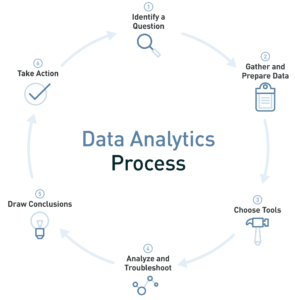
Never forget that hasty decisions and rash actions lead to significant failures. Furthermore, acting on bad data can be worse than not acting at all.
1. Start with the question
An effective VoC analytics program focuses on answering questions.
Before you analyze anything, clearly identify the question (or questions) you want to answer.
For example, a customer experience professional might ask:
- Why were North American sales of our moisturizer down last month?
- What changes should we make to our hotel rooms next quarter?
- How can we improve patient experiences with our drugs and therapies?
The questions you ask will inform:
- The data you gather
- The analytics tools you choose
- The types of analyses you perform
Of course, you may not know the right question to ask. That’s okay! Try starting with something expansive, such as:
“This location seems to be underperforming. Can we see the comments from customers who went there?”
If you’re still not sure, take a step back. Think about your business goals, and what insights would lead to better decisions. Ask yourself: What information would help us improve our products and services?
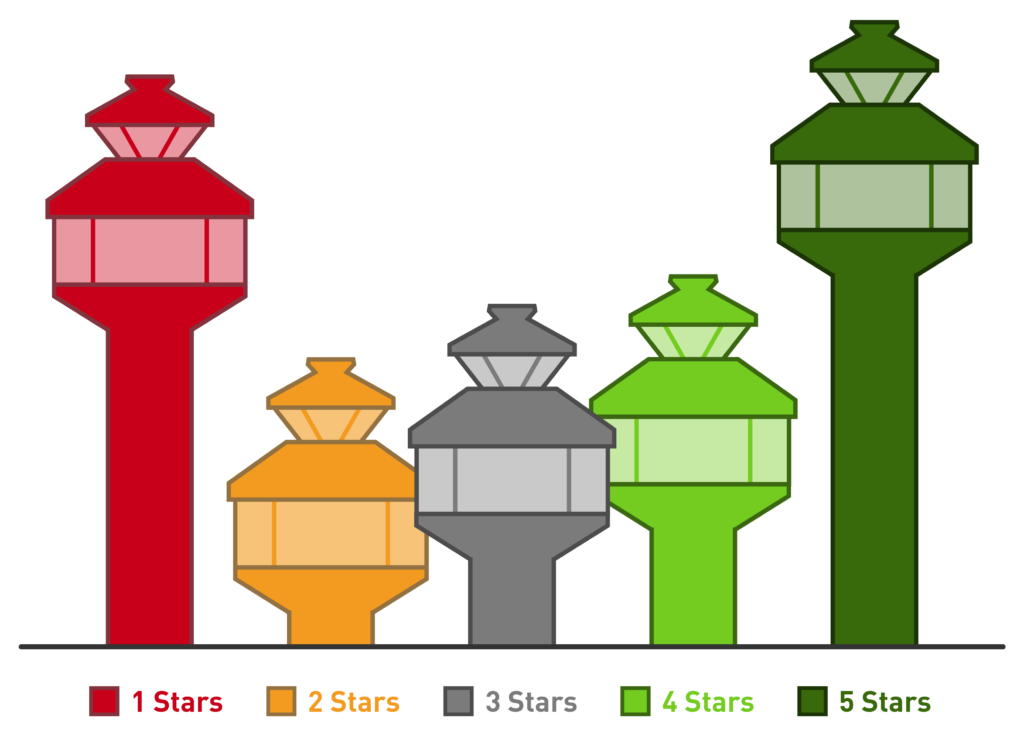
2. Gather and prepare data
Got your question in mind? Now it’s time to gather data.
Above all, the data you collect should be appropriate for your question.
For example, a brand-focused question might demand a mountain of tweets that mention your company.
Alternatively, a product-oriented question could lead you to collect a bundle of customer satisfaction survey responses.

Some common data sources for Voice of Customer analytics programs are:
- Online reviews
- Survey responses
- Support tickets
- Facebook comments
- Tweets
- Chat conversations
- Emails
- Call transcripts
Remember, if you don’t have any data on hand, you can turn to a third-party aggregator such as Socialgist or Sprinklr.
Still not sure where to get the data you need? We can’t source it for you, but we may be able to point you in the right direction. Drop us a line.
3. Choose the right Voice of Customer tools
If you need to compare complex trends over time, a barebones survey analysis tool won’t be able to tell you enough.
Likewise, suppose your goal is to use insights drawn from social media comments as a proxy for customer survey responses. In that case, you need a flexible voice of customer platform that offers rich reporting and customizability.
To get the best return on your investment, choose a solution provider with deep experience solving problems similar to yours.
Above all, don’t rush your decision! Choosing the wrong tool can lead to a failed analytics project and wasted resources.
Here’s some advice from our CEO who recommends you ask four questions when evaluating a potential partner:
- What’s the ROI going to be?
- How experienced is this company?
- Can they tell you about their systems?
- What’s the actual cost to me?
Jeff Catlin – CEO, Lexalytics, an InMoment company
4. Analyze your data
In VoC data analytics, your produced reports should focus on answering your initial questions.
Let’s say you’re asking, “How do travelers feel about Atlanta’s airport?”
To find an answer, you’ve gathered a collection of reviews from Hartsfield–Jackson Atlanta International Airport’s Facebook page. For the sake of argument, let’s say you’ve determined that Lexalytics’ Spotlight web platform is the best tool for the job. (This isn’t just self-promotion: we’ve run this analysis ourselves).
In technical terms, you’ll be most interested in reporting on the themes, entities, and topics discussed in the reviews and the sentiment expressed towards each. Other questions might merit different reports, such as categorization or intention extraction.
Here’s one example of an analysis you might perform. This chart shows sentiment scores mapped against volume over time for reviews that mention the topic “Wayfinding.”
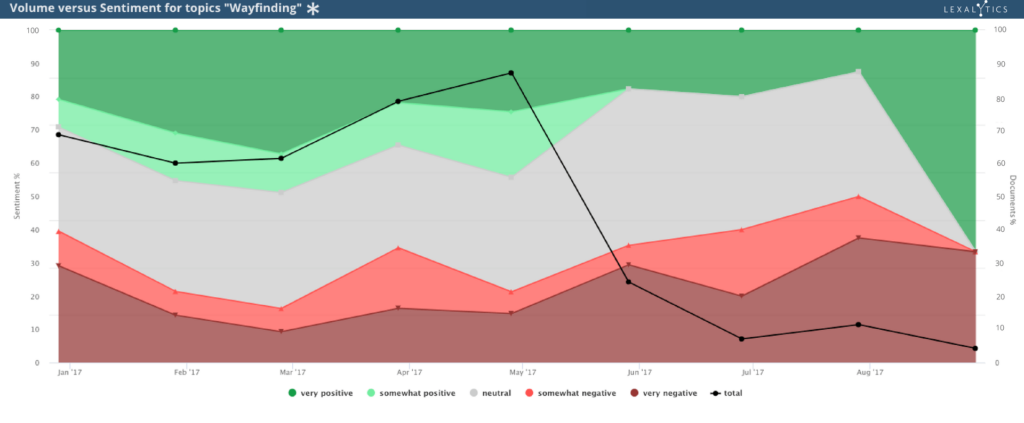 If you’ve chosen the right tool for your VoC analytics program, it should be reasonably easy to identify the correct reports to run.
If you’ve chosen the right tool for your VoC analytics program, it should be reasonably easy to identify the correct reports to run.
So, if you’re struggling to get started, either consult with your solution provider’s support team or go back to step 3.
5. Draw conclusions
Some insights will be self-evident. For example, in the chart above, it’s clear that “wayfinding” is a significant pain point for many travelers.
Meanwhile, this sentiment cloud, extracted from the same data set, clearly indicates negative opinions around the entity of “TSA”. No surprise there!
![Atlanta Airport Sentiment Cloud [AtlantaAirportSentimentCloud.png]](https://www.lexalytics.com/wp-content/uploads/2022/04/Lexalytics-E_Book-2018-Graphics_4-Sentiment_Cloud-1024x484.png)
Other revelations may surprise you. And sometimes, you’ll find answers to questions you hadn’t thought to ask.
Case in point: a hospitality company, while trying to decide which pieces of furniture to upgrade, uncovered a large number of reviews referring to “trash” and “smell” with strongly negative sentiment.
Digging deeper, they discovered that many guests could smell the dumpsters in the parking lot as they entered the hotel!
Unexpected insights like this, drawn from actual customer reviews, are a great demonstration of how a data-driven Voice of Customer analytics program can stand out from the pack.
6. Take action to improve customer experiences
Sometimes, your best course of action will be clear.
In the case of the hospitality company whose guests complained of trash smells, management should look into the possibility of moving the dumpsters.
Or, take this Facebook comment from our analysis of Atlanta International Airport reviews:
“It is a bit confusing. The parking is horrific! Not enough signs for direction and the plane train was definitely anxiety because I didn’t know where the heck it was taking me.”
In this case, it’s evident that just adding more signs and directions would go a long way toward encouraging travelers to return to ATL.
Of course, some conclusions will be more complicated. You may need to drill down into specific data points or run more analyses.
Consider this sample collection of text analytics reports, using traveler reviews from the San Francisco Airport.
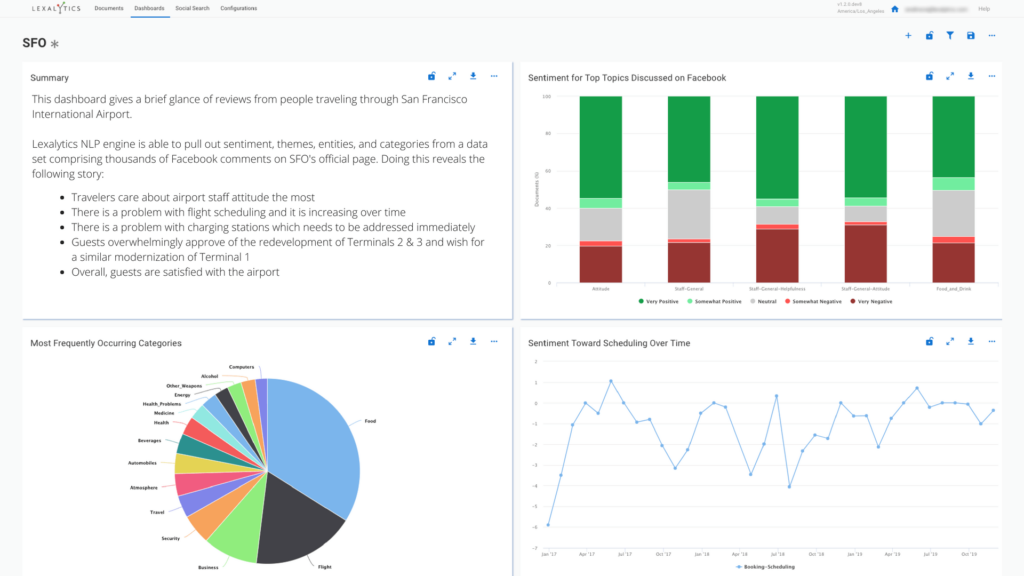
In this example, we’ve written up our interpretation of the results in the Summary section. One conclusion is that there is a problem with flight schedules, which has been increasing over time.
Now, what’s the best course of action here? It’s hard to say. Hundreds of factors may cause flight delays.
However, by collecting, combining, and comparing reports into dashboards like this one, you can uncover the insights you need to start moving down the path to better customer experiences.
Multi-Channel Voice of Customer Analytics: Deeper Insights, Better Results
Analyzing customer reviews and social posts to address individual pain points at speed is a great way to create immediate, tangible value from text analytics.
Ultimately, however, your VoC analytics program should be used to drive decisions across departments. Gartner puts it best:
“VoC data and insights inform many diverse marketing aspects across customer experience, brand, competitive analysis and product development.”
But don’t just take their word for it. According to Aberdeen Group’s research, the key to building a best-in-class VoC program is operationalizing feedback and sentiment data across multiple channels.
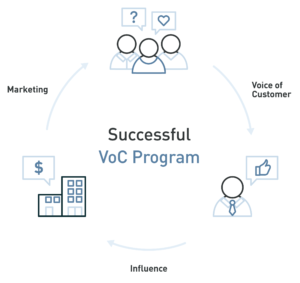 McorpCX, a customer experience services company, argues that data analytics software is best used as a foundation to build more extensive processes.
McorpCX, a customer experience services company, argues that data analytics software is best used as a foundation to build more extensive processes.
They describe VoC analytics as “a great tool to underpin the data gathering and distribution process – especially if you’re collecting and analyzing data from multiple sources and in various formats.”
For example, scroll back up to the dashboard of traveler reviews from the San Francisco Airport. Remember how we noticed a problem with flight schedules, and that this problem has been increasing over time?
Related article: The Crucial Piece that NPS Misses, and How to Fill the Gap
A single department can’t solve this issue alone. But these crucial reports can easily be exported and presented to department heads across the company. Together, using these insights, SFO can start working to solve the underlying issues.
In short, use VoC data analytics to drive decisions in every department: customer success, product management, operations, marketing, and sales. Ultimately, your voice of customer program will become successful by fitting itself into a larger context.
Troubleshooting Your Voice of Customer Analytics
One last note before we wrap up; if you’re struggling to get any helpful information from your reports, take a step back. A messy, unintelligible output might result from a badly-configured analysis, but could also indicate a corrupted data set or system failure.
Don’t forget that the simplest mistakes often cause the most significant errors in data analytics. In our experience, failure usually comes from:
- Starting with the wrong question.
- Using messy, unprocessed data.
- Not configuring the analysis properly.
- Gathering the wrong data for the question.
- Drawing the wrong conclusions.
So, go back to your original question and trace your steps.
- Are you sure you gathered the appropriate data to answer your question?
- Has the data been adequately prepared for analysis?
- Have you consulted all available documentation, tutorials, and guides?
Remember, no one knows your data analytics tool better than the people who built it. Therefore, don’t be afraid to ask your solution provider’s support team for guidance or advice. Requesting help early and often will save you time, money, and headaches.
Voice of the Customer Success Stories
As we’ve shown, text analytics is a vital component of a successful Voice of Customer analytics program. By analyzing surveys, comments, and other text documents, customer experience professionals can gain valuable insights into how customers feel and why they feel that way.
Here are a few real-world examples of how our partners use text analytics and natural language processing to help their clients build data-driven Voice of Customer programs, or to do more with their data.
- This software company helps contact and call centers reduce customer churn 2x faster and increase retention by 10%. – Read more
- Airport architects at Gensler improve traveler experiences by making better-informed decisions about planning and design. – Read more
- AlternativesPharma delivers insights to pharmaceutical marketing teams to help them grow market share and demonstrate value. – Read more
- An American Multinational Technology Corporation tracks 1,000+ products and brands while generating actionable insights three weeks ahead of traditional survey responses. – Read more
If you’d like to discuss how text analytics can fit into your more extensive Voice of Customer program, drop us a line to chat about your situation.
Further Reading and VoC Resources
Here are some great resources for anyone looking to build or improve a data-driven Voice of Customer program:
- Gartner, “Use Voice of Customer Data to Improve Customer Experience Analytics“
- Six Sigma, “Capture Voice of Customer“
- CMO.com, “The Real Value In Voice Of The Customer: The Customer Experience“
- Aberdeen Group, “The Business Value of Building a Best-In-Class VoC Program“
- McorpCX, “Designing a Voice-of-the-Customer (VoC) Program: Beyond Customer Listening to Customer Understanding“
Or, to learn more about text analytics and natural language processing:
- Lexalytics resources library – Natural language processing and text analytics white papers, case studies, and solution profiles
- Blog (you’re already here) – This is where we post technology insights, results from our text analysis projects, and more
Lastly, if you’d like to see our own natural language processing and text analytics solutions in action: